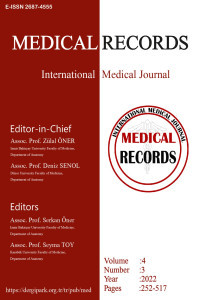Can Cranium Size be Predicted from Orbit Dimensions?
Can Cranium Size be Predicted from Orbit Dimensions?
Cranium, orbit, morphometry prediction, forensic anthropology,
___
- Krogman WM, Iscan MY. The human skeleton in forensic medicine. Springfield, USA: Charles C. Thomas. 1986:18-70.
- Yerli Y, Özkoçak V, Koç F. New approaches ın forensıc anthropology ıdentıfıcatıon studıes. Internatıonal journal of socıal, humanıtıes and admınıstratıve scıences. JOSHAS J. 2021;7:846-56.
- Pires LAS, Teixeira AR, Leite TFO, et al. Morphometric aspects of the foramen magnum and the orbit in Brazilian dry skulls. Int J Med Res Health Sci. 2016;5:34-42.
- Bass WM. Missouri Archaeological Society. Human osteology: a laboratory and eld manual. 5th ed. Columbia (MO): Missouri Archaeological Society. 2005.
- Gnosh R, Chowdhuri S, Maity S. Sexual dimorphism in Right and Left orbital fossa measurements from adult human skulls from an eastern Indian population. J Forensic Sci Med. 2019;79:118-81.
- Chovalopoulou ME, Bertsatos A, Manolis SK. Landmark based sex discrimination on the crania of archaeological Greek populations. A comparative study based on the cranial sexual dimorphism of a modern Greek population. Mediterran Archaeol Archaeomet. 2017;1:37-46.
- Naikmasur VG, Shrivastava R, Mutalik S. Determination of sex in South Indians and immigrant Tibetans from cephalometric analysis and discriminant functions. Forensic Sci Int. 2010;15:1-3.
- Gonzalez PN, Bernal V, Perez SI. Analysis of sexual dimorphism of craniofacial traits using geometric morphometric techniques. Int J Osteoarchaeol. 2009;21:82-91.
- Desai SD, Shaik HS, Shepur MP, et al. A Craniometric Study of South Indian Adult Dry Skulls. J. Pharm. Sci. 2013;5:33-4.
- Kaplanoglu V, Kaplanoglu H, Toprak U, et al. Anthropometric measurements of the orbita and gender prediction with three-dimensional computed tomography images. Folia Morphol. 2014;73:149-52.
- Sung V, Bhan A, Vernon S. Agreement in assessing optic discs with a digital stereoscopic optic disc camera (Discam) and Heidelberg retina tomograph. Br J Ophthalmol. 2002;86:196-202.
- Cramon-Taubadel, NV. Evolutionary insights into global patterns of human cranial diversity: population history, climatic and dietary effects. J Anthropol Sci. 2014;92:43-77.
- Woo EJ, Jung H, Tansatit T. Cranial index in a modern people of Thai ancestry. Anat Cell Biol. 2018;51:25-30.
- Yagain VK, Pai SR, Kalthur SG. Study of Cephalic Index in Indian Students. Int. J. Morphol. 2012;30:125-129.
- Ukoha U, Egwu OA, Okafor IJ, et al. Orbital dimensions of adult male nigerians: a direct measurement study using dry skulls. Int J Biol Med Res. 2011;2:688-90.
- Weaver AA, Loftis KL, Tan JC. CT-based 3D measurement of orbit and eye anthropometry. Invest Ophthalmol Vis Sci. 2010;51:4892-7.
- Mahakkanukrauh P, Sinthubua A, Prasitwattanaseree S, et al. Craniometric study for sex determination in a Thai population. Anat Cell Biol. 2015;48:275-83.
- Ramamoorthy B, Pai MM, Prabhu LV, et al. Assessment of craniometric traits in South Indian dry skulls for sex determination. J Forensic Leg Med. 2016;37:8-14.
- Sangvichien S, Boonkaew K, Chuncharunee A, et al. Sex Determination in Thai Skulls by UsingCraniometry: Multiple Logistic RegressionAnalysis. Siriraj Med J. 2007;59:216-21.
- Marinescu M, Panaitescu V, Rosu M, et al. Sexual dimorphism of crania in a Romanian population: Discriminant function analysis approach for sex estimation. Romanian J Legal Med. 2014;22:21-6.
- Toneva DH, Nikolova SY, Agre GP, et al. Data mining for sex estimation based on cranial measurements. Forensic Sci Int. 2020;315:110441.
- Rooppakhun S, Surasith P, Vatanapatimakul N, et al. Craniometric study of Thai skull based on three-dimensional computed tomography (CT) data. J Med Assoc Thai. 2010;93:90-8.
- Ulcay T, Kamaşak B, Görgülü Ö, et al. A golden ratio for foramen magnum: an anatomical pilot study. Folia Morphol. 2021;81:2206.
- Yayın Aralığı: Yılda 3 Sayı
- Başlangıç: 2019
- Yayıncı: Zülal ÖNER
Anıl ALTIPARMAK, Muhammed Furkan ARPACI, Merve AYDIN, Feyza İNCEOĞLU, Hıdır PEKMEZ
The Use of Botulinum Toxin in Temporomandibular Disorders: A Bibliometric Study
Serkan YILDIZ, Feridun ABAY, S. Kutalmış BÜYÜK
Classification of Bovine Cumulus-Oocyte Complexes with Convolutional Neural Networks
Türker ÇAVUŞOĞLU, Aylin GÖKHAN, Cansın ŞİRİN, Canberk TOMRUK, Kubilay Doğan KILIÇ, Emre ÖLMEZ, Orhan ER, Kemal GÜLLÜ
Selim ÇINAROĞLU, Hasan AKKAYA, Hacı KELEŞ, Fatih ÇİÇEK
Did the COVID-19 Pandemic Period Increased Suicide Attempts in Society?
The Relationship between Spondylolisthesis and Modic Changes: An MRI Study
Veysel DELEN, Alparslan YETİŞGİN, Serap SATIŞ, Safiye KAFADAR, Hamza ERDOĞDU, Saime SHERMATOVA
Hanife KOCAKAYA, Deniz DENİZ ÖZTURAN
Tuba OZCAN METİN, Gulsen BAYRAK, Selma YAMAN, Adem DOĞANER, Atila YOLDAŞ, Nadire ESER, Duygun ALTINTAŞ AYKAN, Banu YILMAZ, Akif Hakan KURT, Mehmet ŞAHİN, Gulsah GURBUZ
Investigation of the Sox-9 and Caspase-6 Immune Activity in Placentas of Pregnant Women with GDM
